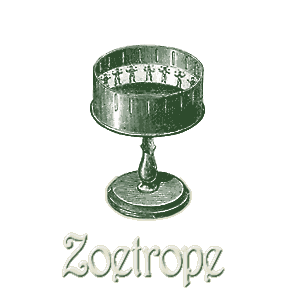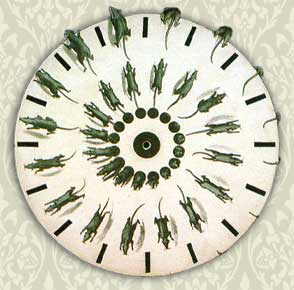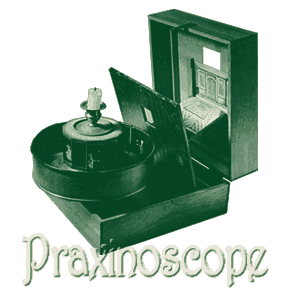

Interactive Module IXb: Early Animation Devices
 |
 |
Images above from: http://web.inter.nl.net/users/anima/optical/phena/index.htm
"The Zoetrope (pronounced ZOH-uh-trohp)was invented by William George Horner (1786-1837) and patented in 1834. It was an early form of motion picture display that consisted of a drum containing a set of still images, that was turned in a circular fashion in order to create the illusion of motion. Horner originally called it the Daedatelum, but Pierre Desvignes, a French inventor, renamed his version of it the Zoetrope (from Greek word root zoo for animal life and trope for "things that turn.")
A Zoetrope is relatively easy to build. It can be turned at a variable rate to create slow-motion or speeded-up effects. Like other motion simulation devices, the Zoetrope depends on the fact that the human retina retains an image for about a tenth-of-a-second so that if a new image appears in that time, the sequence was seem to be uninterrupted and continuous. It also depends on what is referred to as the Phi phenomenon, which observes that we try to make sense out of any sequence of impressions, continuously relating them to each other.
The visual effect created by a Zoetrope (or Zoopraxiscope) is still used today to create animated GIFs and video display technologies such as streaming video, which essentially create an effect of motion by presenting discrete but closely-related images one after the other."
http://whatis.techtarget.com/definition/0,,sid9_gci214341,00.html
Build a Zoetrope: http://www.groeg.de/puzzles/zoetrope.html
Zoetrope activity: http://www.cmp.ucr.edu/exhibitions/education/vidkids/zoetrope.html
3D Zoetrope: http://emsh.calarts.edu/~mathart/Zoetrope.html

 |
 |
 rollover
bird to animate rollover
bird to animate |
The images above are from the following website:
http://web.inter.nl.net/users/anima/optical/phena/index.htm
"The thaumatrope was invented in 1825. Depending on the source, the invention is credited to three different people: Peter Roget, also the creator of Roget's Thesaurus, Dr. John Ayrton of Paris, and Dr. Fitton of London. The thaumatrope is a simple device with two different images, one on the front and one on the back. A piece of string is attached to each side. By quickly rolling the string between your fingers, the two images appear to blend together making one image."
http://www.privatelessons.net/2d/sample/m01_04.html
http://www.randommotion.com/html/thauma.html
 |
rollover image to animate |
Model: Fantascope (Ø 25.7 cm) Artist: Thomas M. Baynes Made by: Rudolf Ackermann, 96 Strand, London (1833)
For more examples of Phenakistascopes and other optical toys go to the following:
http://web.inter.nl.net/users/anima/optical/phena/index.htm
"Developed in 1833 by Joseph Plateau in Brussels, the phenakistoscope is actually one of the oldest motion picture devices. The device consists of a cardboard disc with evenly spaced slots cut along the outside edge. The face of the disc is divided into pie shaped sections containing a series of images. The center of the disc is attached to a stick or dowel so it may spin freely. By holding the image side up to a mirror, spinning the disc, and looking through the slots, the images create a motion picture."
The above quote is from the following website: http://www.privatelessons.net/2d/sample/m01_04.html
Build a phenaskistoscope: http://www.crinkles.com/wolfanim.html
 |
rollover image to animate |
http://www.dtmb.de/Rundgang/Filmtechnik/txt/body2.html
"The praxinoscope, invented in 1877 by Frenchman Charles Reynaud, was the first device to overcome the picture distortion caused by viewing through moving slots. The image produced was more brilliant than other devices and it quickly replaced the zoetrope in popularity. A band of pictures is placed inside an outer cylinder and each picture is reflected by the inner set of mirrors. The number of mirrors is equal to the number of pictures. When the cylinder rotates, the reflected pictures gives the illusion of motion."
http://www.disneylandtoday.com/CaliforniaAdventure/HollywoodPictures/praxinoscope.htm
http://www.privatelessons.net/2d/sample/m01_04.html
http://www.randommotion.com/html/zoe.html
Excellent history leading to the invention of Cinematography: http://www.precinemahistory.net/1830.htm
Optical Toys: http://web.inter.nl.net/users/anima/optical/phena/index.htm